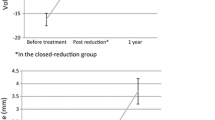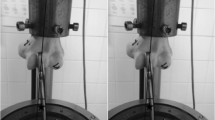Abstract
Bone mineral density (BMD) was measured on three occasions following removal of metal plates used to fixate diaphyseal forearm fractures in eight patients (mean age 38.5 years). At plate removal the mean BMD of the distal radius/ulna and the ulnar shaft sites were, respectively, 10.2% and 2.1% lower than on the nonfractured side. The apparent volumetric BMD (BMDvol) at the ulnar fracture site was 4.3% lower. At 6 months follow-up (n = 5) the mean ulnar shaft BMD had increased by 6.4% (P = 0.04), resulting in complete recovery of BMD, whereas the increase in BMDvol did not reach the BMDvol of the control side. No recovery was found at the distal radius/ulna site. We conclude that there is a small, partially reversible bone density deficit in the ulnar shaft that has been underneath the plate. Although the decreased bone density may in part be responsible for increased refracture risk at the fracture site immediately after plate removal, it is negligible after 6 months. The cessation of the effects of stress shielding is probably responsible for the increased bone density after plate removal.
Similar content being viewed by others
Author information
Authors and Affiliations
About this article
Cite this article
Kettunen, J., KrÖger, H., Bowditch, M. et al. Bone mineral density after removal of rigid plates from forearm fractures: preliminary report. J Orthop Sci 8, 772–776 (2003). https://doi.org/10.1007/s00776-003-0718-7
Received:
Accepted:
Issue Date:
DOI: https://doi.org/10.1007/s00776-003-0718-7




